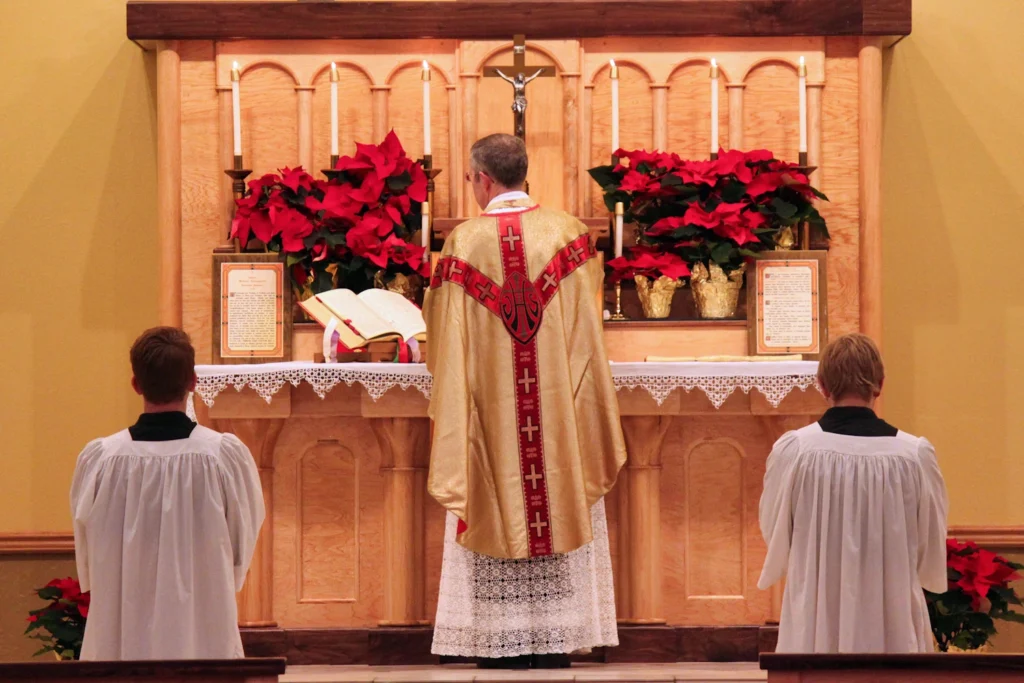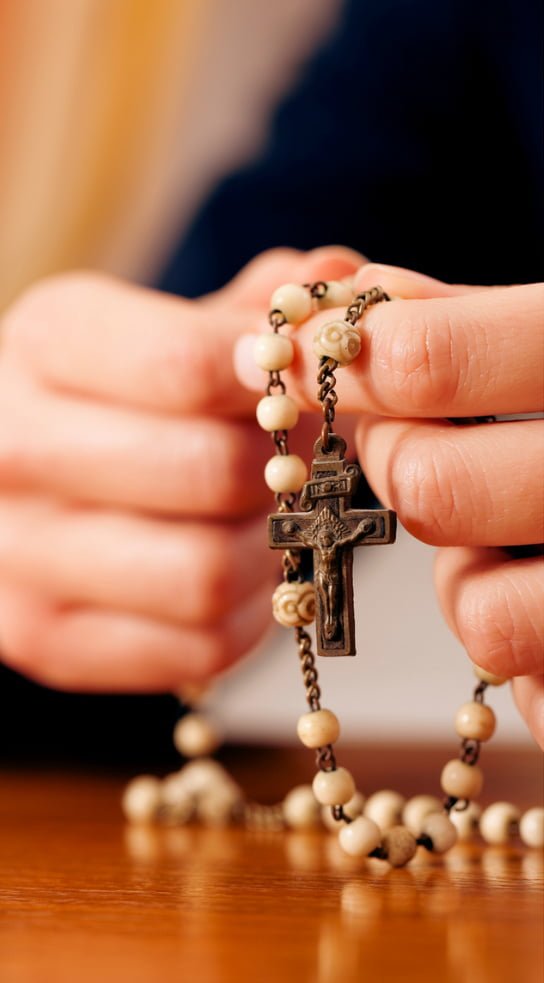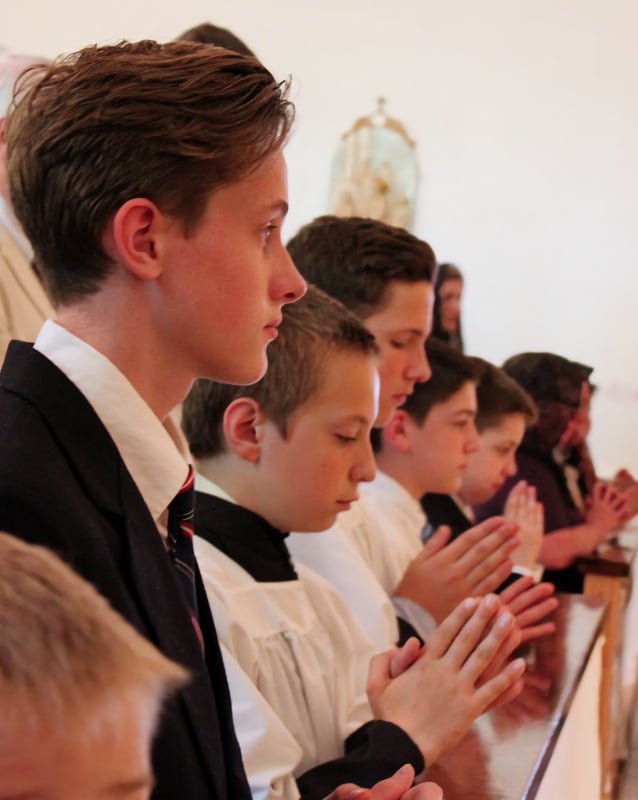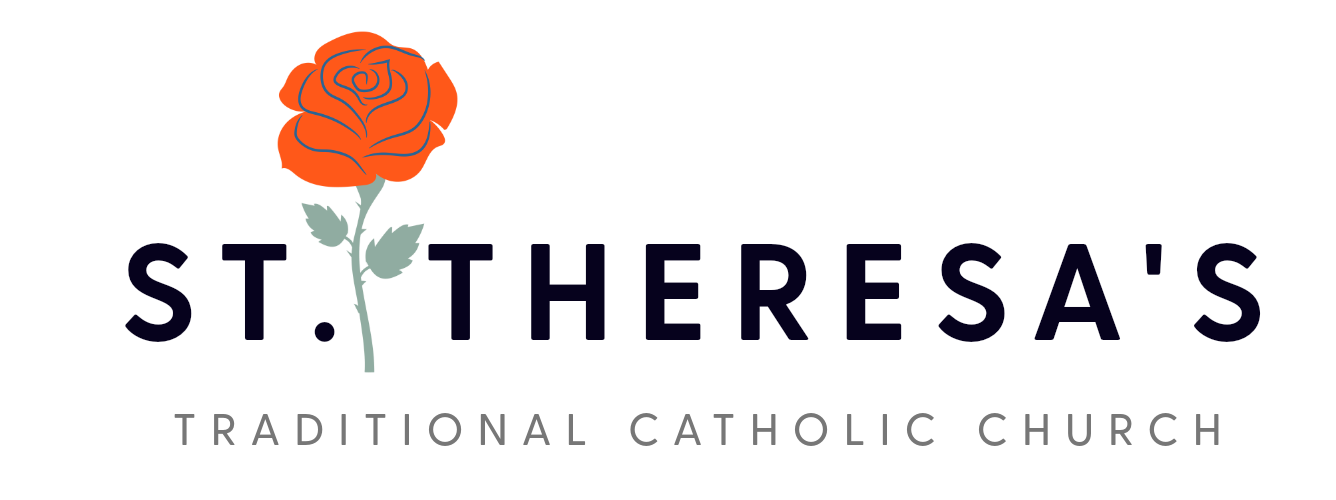Traditional Roman
Catholic Mission
St. Theresa’s Church in Oakland, Maine, is a traditional Roman Catholic Church served by priests of the Congregation of Mary Immaculate Queen (CMRI), who only offer the traditional Latin Mass.
The resident priest is Fr. Gabriel Lavery. Fr. Gabriel was ordained to the holy priesthood on May 31, 2003. Since then he has served in several different parishes of the Congregation.


Sunday Mass Schedule
- Confession 8:30 AM
- Rosary 9:05 AM
- Mass 9:30 AM
"A word, a kindly smile, will often suffice to gladden a wounded and sorrowful heart."
Saint Theresa
Welcome
Visitors to St. Theresa’s Traditional Catholic Church will notice that the Mass is celebrated according to the traditional Latin Rite and that we have remained faithful to the Catholic Church’s teachings as they have been passed down through the ages.
We are pleased to have you join us at St. Theresa’s Traditional Catholic Church. We believe that our adherence to the traditional Latin Rite and the Catholic Church’s teachings will provide you with a unique and Christ-centered experience. Our community is dedicated to upholding the rich traditions of our faith and sharing them with all who seek to deepen their relationship with God.
As a visitor, you will find a welcoming and friendly environment at St. Theresa’s. We encourage all members of our congregation to extend a warm greeting to our guests and make them feel at home. Whether you are a lifelong Catholic or new to the faith, we invite you to join us in prayer, adoration, and service to others. Our doors are open to all, and we look forward to the opportunity to share our faith with you.
We love seeing new faces at St. Theresa’s Church and hope to see you soon.


At St. Theresa’s, we exclusively offer the traditional Latin Mass. Our adherence to past infallible teachings of the Catholic Church is what guides us. We have preserved the Latin Mass, as well as all the traditional teachings of the Church that have been passed down through the centuries, because it aligns with Catholic principles.
At St. Theresa’s, we exclusively offer the traditional Latin Mass. Our adherence to past infallible teachings of the Catholic Church is what guides us. We have preserved the Latin Mass, as well as all the traditional teachings of the Church that have been passed down through the centuries, because it aligns with Catholic principles.
The Traditional Latin Mass plays a vital role in protecting the Catholic Faith. According to Pope Pius XII, the sacred liturgy is closely intertwined with the truths of the Catholic Faith, and must, therefore, reflect these truths. In fact, the liturgy serves as a safeguard for the integrity of the Faith (Mediator Dei). As a result, the Church has always taken great care to safeguard the text of the Mass, so as to prevent any doctrinal errors from seeping into the liturgy. The traditional Latin Mass serves as a perfect expression of the unchanging truths of the Catholic Church.
Even the Protestant reformers recognized the connection between Church teaching and the Mass. Luther believed that overthrowing the Mass would also overthrow the papacy. He and other Protestant reformers deliberately eradicated the idea of sacrifice from their “reformed” liturgies. They removed altars and crucifixes, replacing the concept of the Real Presence of Christ in the Blessed Sacrament with Scripture readings and sermons. This was a gradual process, which made it difficult for Catholics to recognize the changes, and they gradually began to adopt Protestant practices.
Since the early 1960s, many of these same changes have been gradually introduced into Catholic churches. In 1969, a Vatican commission, assisted by six Protestant theologians, rewrote the Mass. The new liturgy no longer contains references to the Mass as a sacrifice, and is defined as “the memorial of the Lord.” It closely resembles a Protestant service. The New Mass is not an expression of the traditional Catholic Faith but rather a new ecumenical religion.
The Mass is offered in Latin because it is considered a “dead” language. Since it is no longer used as a vernacular language in any country today, the Latin words will not change in meaning. In contrast, the English language we use is subject to slang, colloquialisms, and various local influences, which can cause words to have different meanings from place to place and year to year. As Pope Pius XII stated, “The use of the Latin language… is a clear and beautiful sign of unity, as well as an effective remedy for any corruption of doctrinal truth” (Mediator Dei).
Although some may find it difficult to understand Latin, most missals display the English translation side-by-side with the Latin text. Even children can learn to use them with ease and quickly become familiar with many of the Latin prayers.
In the Holy Mass the priest offers sacrifice to God. The priest fulfills a role as mediator between the people and Almighty God. The focus of the worship is God Himself. The priest is oriented towards God.
During the Mass, the faithful participate by offering it as a sacrifice in union with the priest. As baptized Catholics, we participate in the priesthood of Jesus Christ. By following the prayers of the Mass found in the missal, we join in the Mass and offer it in union with the priest. Through this participation, we can offer the Mass and unite our daily actions with the great and unique sacrifice of Christ.
The Catholic Church observes the admonition of St. Paul in 1 Corinthians, Chapter 11: “Doth it become a woman to pray with head uncovered?” The Apostle exhorts Christian modesty and decorum in the celebration of the divine worship.
Modest and appropriate attire at Holy Mass is a sign of respect for Our Lord in the Blessed Sacrament and of fraternal charity for our neighbor.
The word “Tridentine” is simply a reference to the fact that the Latin Mass was codified by Pope St. Pius V shortly after the Council of Trent (1545-1563), from which is derived the term “Tridentine.” Contrary to what some people think, Pope St. Pius V did not issue a new Mass but simply unified the already existing liturgy. His Quo Primum decree not only declared that this Mass was to remain unchanged for all time, but it forbade the introduction of new Mass liturgies.
The origins of the Roman Mass can be traced back to the writings of St. Justin (150 A.D.) and St. Hippolytus (215 A.D.). By 250 A.D., the Mass was being celebrated in Latin throughout most of the Roman world, and the Latin Canon as we know it was completed by 399 A.D. Despite some minor changes over time, the Mass has remained largely the same since the days of the Apostles. However, it was formally codified in its present form by Pope Pius V in the sixteenth century.
For many centuries, the Catholic Mass has remained unchanged, with a Catholic attending a Mass anywhere in the world finding it to be the same. This consistency extends even through time, as a Mass offered in Rome in 570 would be remarkably similar to one offered in the same city in 1570, or in Japan in 1940, or at St. Theresa’s today. This unchanging nature of the Mass reflects the unity and universality of the Catholic Church, two of the four marks that distinguish it as the one true Church established by Christ. The Catholic Church possesses all four of these marks: unity, holiness, universality, and apostolicity. It is one because all members profess the same faith, celebrate the same Sacraments, and are united under the same authority. It is holy because it was founded by Jesus Christ, teaches holy doctrines, and provides the means for living a holy life. It is universal because it is empowered to receive all people in all places and times. Lastly, it is apostolic because it was founded by Christ on the apostles and has been governed by their lawful successors.
Some individuals may argue that they don’t find the traditional Latin Mass to be engaging or fulfilling. They may claim that the use of Latin makes it difficult to understand, or that the priest doesn’t do enough to involve the congregation. They might also express a preference for more contemporary, upbeat music during the service. However, it’s important to remember that the Mass is not intended to cater to our personal preferences or entertain us. It’s a form of worship designed to give glory to God.
As the Catechism of the Catholic Church explains, the Mass serves several purposes: to adore God as our Creator and Lord, to thank Him for His blessings, to ask for His assistance for ourselves and others, and to make reparation for sins. Additionally, the Mass is the public worship offered by the entire Church to God through Jesus Christ, who acts as the Eternal High Priest. During the Mass, Christ offers Himself to the Father as the sacrificial Lamb, taking away the sins of the world.
Ultimately, the Mass is the fulfillment of prophecy: “From the rising of the sun even to the going down…in every place there is sacrifice and there is offered to my name a clean oblation” (Malachi 1:11). So while personal preferences can vary, the Mass is a sacred and unchanging form of worship that has been offered by the Church for centuries.

Dress Code
If you are attending the Traditional Latin Mass for the first time, you may have noticed that our parishioners do not dress casually in the church. We believe that modesty and appropriate attire are required, particularly in Church, out of reverence for the Blessed Sacrament. Please adhere to the following minimum dress standards when attending Church services:
Women and girls must cover their heads. Chapel veils or mantillas are available for loan in the vestibule. They should also wear dresses or skirts that cover the knee completely when standing or sitting. Slacks, shorts, sleeveless, tight, skirts with long slits or low-cut clothing are not permitted.
Men and boys should wear a suit coat and tie. Jeans and other casual attire are inappropriate for attendance at Church services.
Holy Communion
We ask that you please speak with Father before receiving the sacraments at St. Theresa’s unless you exclusively attend the Traditional Latin Mass.
